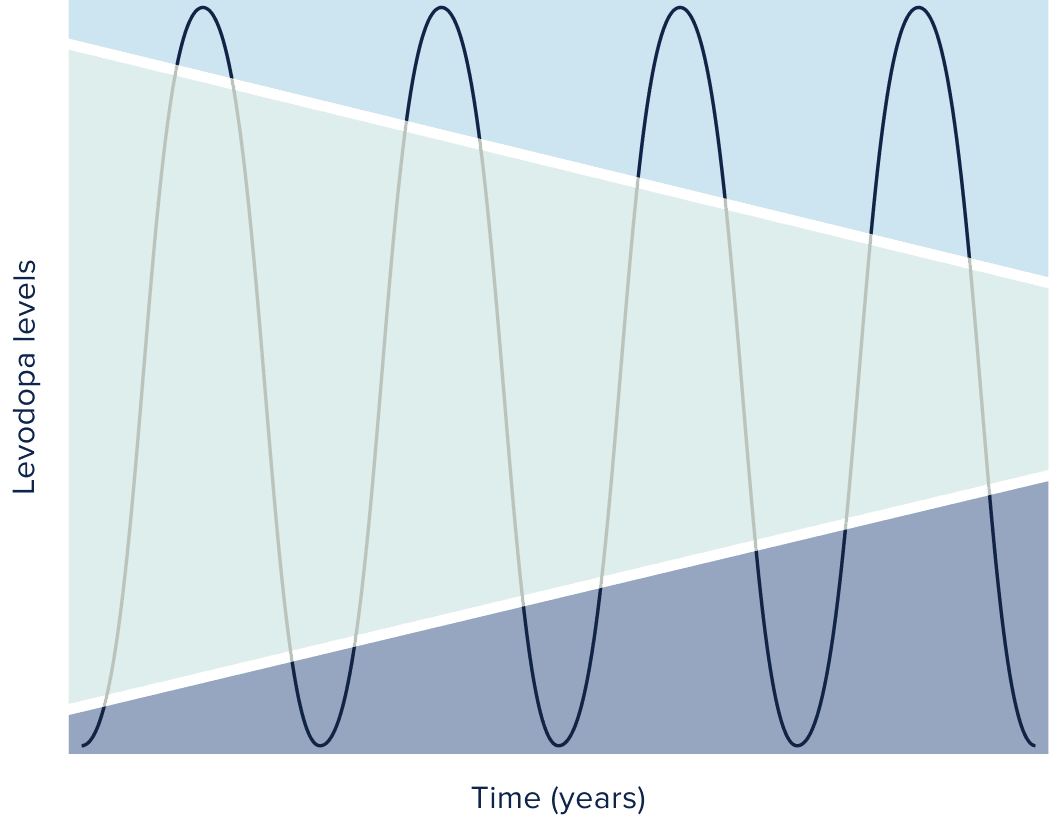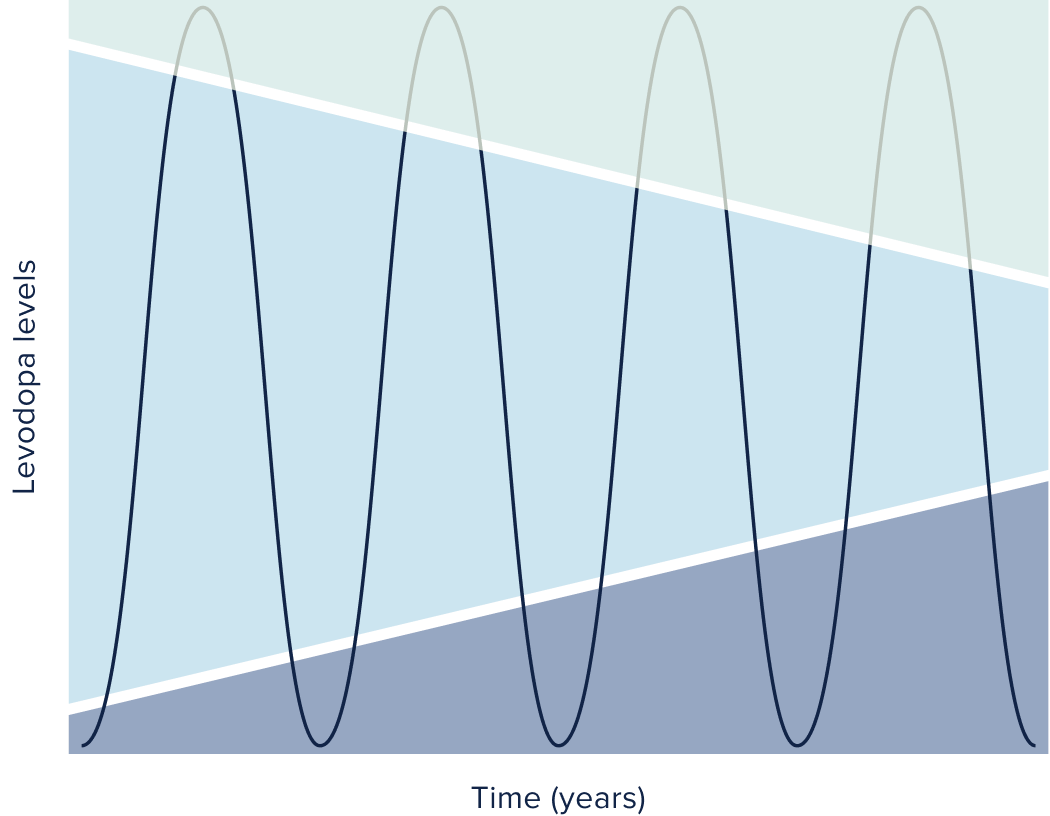By continuing to use this site, you agree to our use of cookies as described in our Cookie Policy.
About “GOOD ON” TIME
Understanding the ups and downs of IR CD/LD

LEVODOPA LEVELS
IR CD/LD has been the standard of care for treating PD for many years—it’s designed to work quickly but may wear off quickly too.
Dyskinesia happens when your medicine is working, but the level of levodopa is too high and you may experience movements you can’t control
“Good On” time is when your medicine is working, and you are not experiencing dyskinesia or it is not troubling you.
“On” time is when your medicine is working and your symptoms are well-controlled, but you may be experiencing troublesome dyskinesia
“Off” time is when your medicine is not working and symptoms return
Dyskinesia happens when your medicine is working, but the level of levodopa is too high and you may experience movements you can’t control
“Good On” time is when your medicine is working, and you are not experiencing dyskinesia or it is not troubling you.
“On” time is when your medicine is working and your symptoms are well-controlled, but you may be experiencing troublesome dyskinesia
“Off” time is when your medicine is not working and symptoms return


Over time with IR CD/LD, the duration of your symptom control may become more unpredictable, and you may experience more “Off” time. In fact, about half of patients taking a PD medication may experience “Off” episodes within 2 to 3 years of being on treatment
If you are noticing fluctuations with your IR CD/LD treatment, it could be helpful to track your “Good On” time*, “On” time, and “Off” time after each dose.
This information can not only be helpful for you, but it can also provide essential information when speaking with your doctor.
Footnotes
*“Good On” time is defined as “On” time without troublesome dyskinesia.
CREXONT® (carbidopa and levodopa) extended-release capsules is a prescription medication for the treatment of Parkinson’s disease, Parkinson’s disease caused by infection or inflammation of the brain, or Parkinson’s disease-like symptoms that may result from carbon monoxide or manganese poisoning in adults.
Do not take CREXONT with antidepressant medications known as nonselective monoamine oxidase (MAO) inhibitors.
Do not take CREXONT with other carbidopa-levodopa preparations without consulting your healthcare provider.
CREXONT may cause falling asleep during activities of daily living, somnolence, or dizziness. Avoid activities that require alertness such as driving and operating machinery until you know how CREXONT affects you.
The most common side effects that may occur with CREXONT are nausea and anxiety.
It is important to avoid sudden discontinuation or rapid dose reduction of CREXONT. If you are discontinuing CREXONT, work with your healthcare provider to taper the dose over time to reduce the risk of fever or confusion.
You may take CREXONT with or without food, but taking it with food may decrease or delay its effect. Consider taking the first dose of the day about 1 to 2 hours before eating.
Swallow CREXONT whole. Do not chew, divide, or crush the capsules.
Do not take CREXONT with alcohol.
Tell your healthcare provider if you:
CREXONT® (carbidopa and levodopa) extended-release capsules is a prescription medication for the treatment of Parkinson’s disease, Parkinson’s disease caused by infection or inflammation of the brain, or Parkinson’s disease-like symptoms that may result from carbon monoxide or manganese poisoning in adults.
To report SUSPECTED ADVERSE REACTIONS, contact Amneal Specialty, a division of Amneal Pharmaceuticals LLC at 1-877-835-5472 or the FDA at 1-800-FDA-1088 or www.fda.gov/medwatch.
Please read the full Prescribing Information. For more information talk to your healthcare provider.
CREXONT® (carbidopa and levodopa) extended-release capsules is a prescription medication for the treatment of Parkinson’s disease, Parkinson’s disease caused by infection or inflammation of the brain, or Parkinson’s disease-like symptoms that may result from carbon monoxide or manganese poisoning in adults.
Do not take CREXONT with antidepressant medications known as nonselective monoamine oxidase (MAO) inhibitors.
Do not take CREXONT with other carbidopa-levodopa preparations without consulting your healthcare provider.
CREXONT may cause falling asleep during activities of daily living, somnolence, or dizziness. Avoid activities that require alertness such as driving and operating machinery until you know how CREXONT affects you.
The most common side effects that may occur with CREXONT are nausea and anxiety.
It is important to avoid sudden discontinuation or rapid dose reduction of CREXONT. If you are discontinuing CREXONT, work with your healthcare provider to taper the dose over time to reduce the risk of fever or confusion.
You may take CREXONT with or without food, but taking it with food may decrease or delay its effect. Consider taking the first dose of the day about 1 to 2 hours before eating.
Swallow CREXONT whole. Do not chew, divide, or crush the capsules.
Do not take CREXONT with alcohol.
Tell your healthcare provider if you:
CREXONT® (carbidopa and levodopa) extended-release capsules is a prescription medication for the treatment of Parkinson’s disease, Parkinson’s disease caused by infection or inflammation of the brain, or Parkinson’s disease-like symptoms that may result from carbon monoxide or manganese poisoning in adults.
To report SUSPECTED ADVERSE REACTIONS, contact Amneal Specialty, a division of Amneal Pharmaceuticals LLC at 1-877-835-5472 or the FDA at 1-800-FDA-1088 or www.fda.gov/medwatch.
Please read the full Prescribing Information. For more information talk to your healthcare provider.
CREXONT® is a registered trademark of Amneal Pharmaceuticals LLC. © 2025 Amneal Pharmaceuticals LLC.
Distributed by Amneal Specialty, a division of Amneal Pharmaceuticals LLC.
All rights reserved. PP-IPX203-US-0026 06/2025
This is intended for residents of the United States only. Any product discussed herein may have different product labeling in different countries. Please read the full Prescribing Information and discuss it with your doctor or healthcare professional.